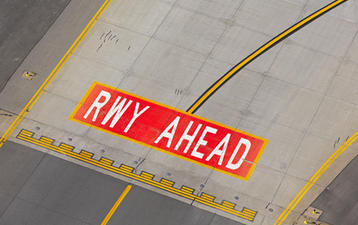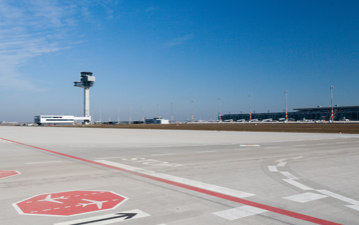Redesign of Aircraft Parking Stands to Ensure Compliance with European Regulations
Frankfurt Airport
Aerodrome operators around the world face the challenge of being bound to use airside infrastructure designed and constructed decades ago – with limited potential to adapt to modern aircraft fleet mix demands. Hence, the design characteristics of new aircraft types, especially regarding length and wingspan, often render it difficult to park these types in a compliant manner in terms of minimum clearance distances on aircraft stands as per applicable regulation, e.g., ICAO Annex 14 or EASA Certification Specifications for Aerodrome Design. airsight worked together with numerous clients around the world to address corresponding compliance issues.
In 2020, airsight has been appointed by Fraport AG, the operator of Germany’s largest airport in Frankfurt, to redesign 65 aircraft parking positions aiming for compliance in terms of minimum clearance distances on aircraft stands as per EASA Certification Specifications for Aerodrome Design. The project is divided into six phases each dealing with a defined set of parking positions with the last one envisaged to be finished in early 2023. The concerned stands are located on different aprons and serve differing purposes, like passenger handling with boarding bridges, passenger busing operations and freight operations. Furthermore, a number of stands is arranged in a superimposed way (so called multiple aircraft ramp stands, MARS) to cater for varying sizes of aircraft to be accommodated. Aside the parking position itself, a revision of aircraft movements on adjacent taxilanes including stand entry and pushback processes as well as corresponding ground markings is taken into consideration.
Besides the mere compliance with the regulations regarding minimum clearance distances on aircraft stands, several operational constraints and requirements must be adhered to. This concerns especially the operation of passenger boarding bridges taking into account manoeuvring capabilities and maximum allowed tunnel slopes when docked to an aircraft door. The possibility to dock multiple bridges independently, the local requirements addressing the fuelling through underground pits, the operation of fixed ground power units, and the safe manoeuvring of numerous ground handling vehicles around the parked aircraft need to be factored in as well.
In addition, rather unique apron elements are implemented at Frankfurt Airport including height restricted service roads running below the tails of parked aircraft and height restricted GSE staging areas underneath the aircraft’s wingtips. Thus, sufficient vertical clearances must be ensured when revising concerned apron areas.
The primary measure applied to address non-compliant stand clearance distances is the revision of the airfield ground markings layout including, where appropriate, the relocation or realignment of stand centre lines, the revision of location and allocation of nose wheel stop lines, and the adjustment of boarding bridge parking positions. Further measures considered comprise the relocation of A-VDGS units, fuel pits, GPU and jet blast fences as well as of apron roads and associated road-holding positions.
The redesign of apron areas has been strongly based on the simulation of aircraft, boarding bridge and vehicle operations conducted with the CAD-based software Transoft AviPLAN®. Here, both current airline fleet mixes and aircraft types to be introduced in the years to come are provided for.
If you too need support for the planning or redesign of apron areas and aircraft stands, please feel free to contact us via e-mail our through our website.
Photo Credit: Bohdan Skudrzyk, Fraport AG
Key Facts



